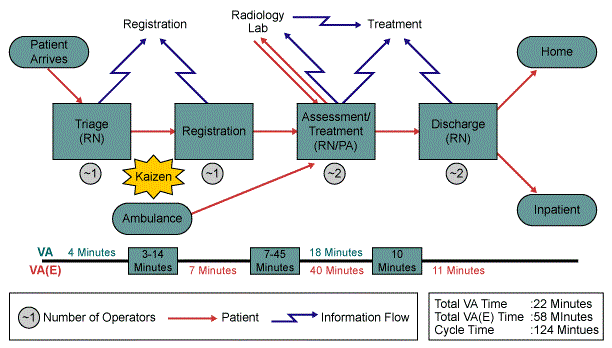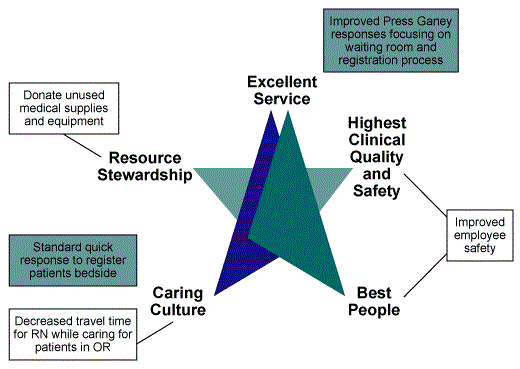
Among great strides in quality and efficiency achieved by Virtua Health in New Jersey, USA, in recent years are the results achieved by process improvement teams at the healthcare system’s 95-bed Virtua West Jersey Hospital Berlin in the emergency department, operating room and central sterile supply.
The Virtua Hospital Berlin initiative focused on visual improvements of clinical operations in the specified areas, reduction of inventory costs, enhancement of employee satisfaction and safety, and most importantly better serving patient needs. Specifically, the teams at Berlin were charged with eliminating patient and employee safety related issues in the operating room (OR) and creating a systematic collaboration between the central sterile supply (CSS) and the OR as it related to equipment processing. In the emergency department (ED), the challenge was to improve the reception area and triage as seen through the eyes of patients.
The first step was to understand current processes through time observation studies, stakeholder interviews, spaghetti charts and value stream maps (Figure 1), then to identify waste in the process. Waste elimination was highlighted in the value stream map in the form of wait time for ED patients and travel time for the nursing staff in the OR.

Visual Management Tools and Observation
To improve satisfaction and efficiency in the emergency department, the ED team decided to start the continuous improvement journey at the first step – the reception area and triage. This was the patients’ first interaction with the hospital. Cluttered areas made it difficult for patients to identify the process they needed to navigate for treatment. This created a negative impression that was reflected in patient satisfaction surveys. It was decided that visual management tools, such as 5S, were to be implemented to simplify the process for both patients and clinical staff.
In the OR, nurses were forced to take many trips into the supply storage area to obtain supplies and equipment during surgeries, interrupting the flow of that process. Licensed clinicians were “picking” cases, during the day, as their schedule allowed. The observations further revealed employee safety issues (trip hazards, blind spots, movable rolling racks, etc.) in the storage room. The observation tool “golf score” was used to assign points to the physical motions nurses used while preparing case carts. This tool helped to identify excessive motion of the staff in the preparation process. It indicated staff reaching where they could not see, bending and lifting. The team’s actions improved the case cart golf score from 417 to 91.
The team also noticed a large amount of clutter and excessive inventory in both the CSS and the OR. The goal for the CSS and the OR was to reduce the inventory and create a replenishment method to keep the inventory in control. That team also initiated a pilot project utilizing “just in time” (JIT) concepts to start the case carts in the CSS. The incorporation of JIT concepts allowed staff from the CSS to pick carts in the CSS and deliver to the OR only when the supplies and equipment were actually needed.
With approval from the hospital’s executive sponsors, the visual improvement goals were set and aligned with the Virtua Star of excellence (Figure 2).

The Kaizen Event and Trystorming
The two teams were split into sub-teams, one for each identified area. The sub-teams observed the process firsthand and reviewed pre-work completed by Kaizen leaders during the previous few weeks. Upon their return into the meeting rooms, the teams then used Work-Out tools to brainstorm solutions and put together an implementation, or “trystorm,” plan for the next day.
Day 2 and 3 of the Kaizen event were devoted to making the actual changes. Of course, during this period the OR/CSS and the ED were still receiving and treating patients. The ED team identified ideas it wanted to trystorm in the actual area, including simplifying the patient sign-in process, removing unnecessary clutter, and actually trystorming a new streamlined triage process for the patients. One result was an overall reduction of the registration/triage time range of 70 percent. The team also decided that in order to visually improve the area a new coat of paint would be beneficial. That idea was immediately embraced by the medical director, who donated his own time to the cleaning and painting.
After reviewing current case mixes and use of supplies, the CSS/OR team moved mountains of inventory, removed massive amounts of clutter, and disposed of outdated and unused supplies. This was a labor- and time-intensive undertaking, but by the last day the team was able to put the pieces together again in order to see these improvements visually. The OR/CSS not only became a cleaner and more organized environment, but the team also was able to donate and redistribute many medical supplies to other ORs in the healthcare system. Outdated equipment and supplies were disposed of and safety hazards that had been identified in the areas were removed. The reclaimed space was then marked to clearly identify tasks that were to be performed and to avoid future possibility of clutter.
While the majority of the team focused on reclaiming control over the actual storage area, the CSS sub-team removed trip hazards and reorganized the actual CSS storage area. It also created a first step to a JIT system that would start the cases in the CSS and would free up space by only delivering the supplies and equipment needed for surgeries the next day. This also increased the teamwork between the two physically separated teams and removed non-essential tasks, creating greater value for the clinical team.
Sustaining Changes with 30-Day Action Plan
As some of the ideas and tasks could not be accomplished in the actual Kaizen week, a 30-day follow-up action plan helped to assure items were completed and changes could be sustained. Beyond the physical changes, the teams also implemented an improved replenishment system in the OR to further reduce on-hand inventory, spread visual controls to other areas in the OR, and adjusted the patient sign-in and triage process in the ED. Everyone caught the true Kaizen spirit of continuous improvement, striving for better patient care every day.
Leadership involvement is critical to the success of such initiatives, and the team received support from local leadership throughout and after the event. Executives engaged in the process included the hospital’s chief operating officer, the vice president for patient care, the assistant vice president of operations and the quality director. This alongside with the participants from the area, the facilities team, and the fresh eyes from outside the area were important factors to creating this visual success story.
As Pat Williams, nurse director of the hospital’s emergency department, said, “This has been an incredible experience to see the process through the eyes of the patient. And the great thing is, it still continues to spread.”